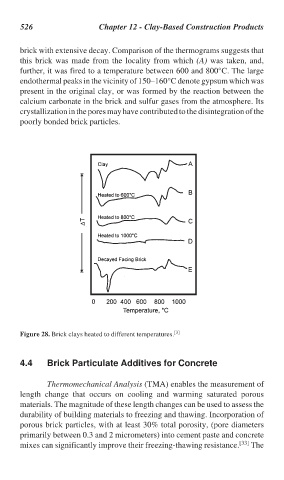Page 556 - Handbook of Thermal Analysis of Construction Materials
P. 556
526 Chapter 12 - Clay-Based Construction Products
brick with extensive decay. Comparison of the thermograms suggests that
this brick was made from the locality from which (A) was taken, and,
further, it was fired to a temperature between 600 and 800°C. The large
endothermal peaks in the vicinity of 150–160°C denote gypsum which was
present in the original clay, or was formed by the reaction between the
calcium carbonate in the brick and sulfur gases from the atmosphere. Its
crystallization in the pores may have contributed to the disintegration of the
poorly bonded brick particles.
Figure 28. Brick clays heated to different temperatures. [3]
4.4 Brick Particulate Additives for Concrete
Thermomechanical Analysis (TMA) enables the measurement of
length change that occurs on cooling and warming saturated porous
materials. The magnitude of these length changes can be used to assess the
durability of building materials to freezing and thawing. Incorporation of
porous brick particles, with at least 30% total porosity, (pore diameters
primarily between 0.3 and 2 micrometers) into cement paste and concrete
mixes can significantly improve their freezing-thawing resistance. [33] The

